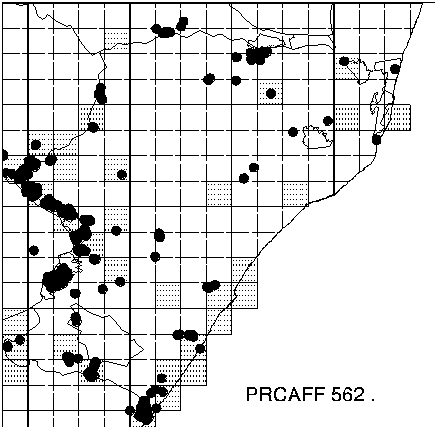
Home
Mission
Overview of Project
Project Staff
Sponsors
Achievements
Checking, Illustrations
Upcoming Activities
Id and Species Lists
Protea Information
Protea Gallery
Growing Proteas
Interim Dist. Maps
Publications
Afrikaanse Inligting
![]()
IDM KwaZulu-Natal - Highveld Sugarbush - Protea caffra caffra
 A solid
black dot indicates where the species is found.
A solid
black dot indicates where the species is found.
Protea caffra caffra - Highveld Sugarbush has leaves 13-30 mm wide, with wedge-shaped bases. The flowerheads are 40-70 mm long and petal tubes are 10-14 mm long. It is very variable with many races recognized by John Beard and sunk by John Rourke - of which the following occurred in the area:
- caffra (Drakensberg from Royal Natal to Swaziland) with broader (15-25mm) leaves and larger bracts;
- multibracteata (midlands, forelands and Drakenberg proper) [including: baurii, Jlanaganii, natalensis, pegleriae] with narrower leaves (8-25mm) and smaller bracts.
PR CAFF C is the most widespread and common protea in KwaZulu-Natal. It occurs throughout the province and may occur in most grid squares. It has been atlassed 451 times, making it by far the most commonly atlassed protea - in 51% of our atlassed sites. But it is very poorly recorded, being regarded as "too common to be of importance". We definitely need more records for this species - please do not take this attitude!
New records for this species have been received from around Vryheid, Umfolozi, Mzimkhulu WA, Howick, Elephant Hill. It must be a lot more common in the area, based on all the areas for which we do not have data. If you know of any areas with this species, do not assume that because it is common we have enough data or that someone else is sure to have atlassed it.Areas with known records of PR CAFF C not yet atlassed, for which we need data:
l. Ladismith/Wakkerstrm/Vryheid
2729 BD Volksrust Wakkerstroom
2829 AB Swinburne Rensburghkop
2829 BA Balbrogie & Biggarsbush
2829 CB Bergville Mt Mount Aux Sources
2. Natal North Coast
2831 DC Ngoye
2832 AA Hluhluwe GR 365m
2832 BA Hlabisa SW Lake Bengazi 30m
3. Natal Midlands
2830 DD Kranskop
4. Matatiele Drakensberg
3028 BB Ramatselitsos nek on Matatiele rd
3028 BD Mt Fletcher
3028 DB Ndindini
5. Richmond Area
2930 CD Deepdene One-o'clock Hill
6. Durban/South Coast
2931 CA Amatikulu 2931 CC Black Hill
3030 BB Mkembati NR Daza River
3030 DA Umzumbi River
Elsa Pooley's map (page 86) gives far more unatlassed records than those mentioned above (shown as 0). Particularly, she denotes the species as occurring far more extensively between Durban and Pietermaritzburg, virtually everywhere in southern KwaZulu Natal and far more common northwest of Vryheid. Other records for Tugela Valley and St Lucia are also shown.
Please help us to fill in the gaps in our data.
The Grassveld Sugarbushes are among the most 'primitive' of the Sugarbushes found in southern Africa and are best distinguished from the Mountain and Savanna Sugarbushes by their hairless or near hairless involucral bracts, although some species do have hairs. It is difBcult to rigorously define the group, but the following characters are helpful:
- young stems are hairless, as are the involucral bracts (except in P. caffra);
- flower-heads tend to be less than 50 mm long, except P. caffra), or to have a long scaly stalk;
- flowers may either protrude or be contained within the involucral bracts;
- the petals may be hairless or hairy, occasionally with a tuft of hairs on the tip;
- styles are usually strongly curved; and
- the leaves are hairless.
Young Pr caffra plants are very similar to Pr simplex. Although adult Pr caffra are trees, they need to grow large enough to survive fires. Thus young plants form an underground rootstock and produce many stems, which are burned down with every fire, until stems are thick enough to "escape" fires and thus grow up into trees. The moment one branch is thick enough, the other basal branches are shed and the plant assumes its tree-like habit. It thus differs from Pr simplex, which never grows into a tree, and its thin branches usually burn in every fire. The easiest way to distinguish the two species is by the very thin stems in Pr simplex, and the much thicker stems in Pr caffra. The stems in Pr caffra are often branched - seldom so in related species. Pr caffra may stay as a resprouter for decades until fire frequency and intensity allow escape into the tree form. Both differ from Pr parvula with its creeping stems laying flat on the ground.